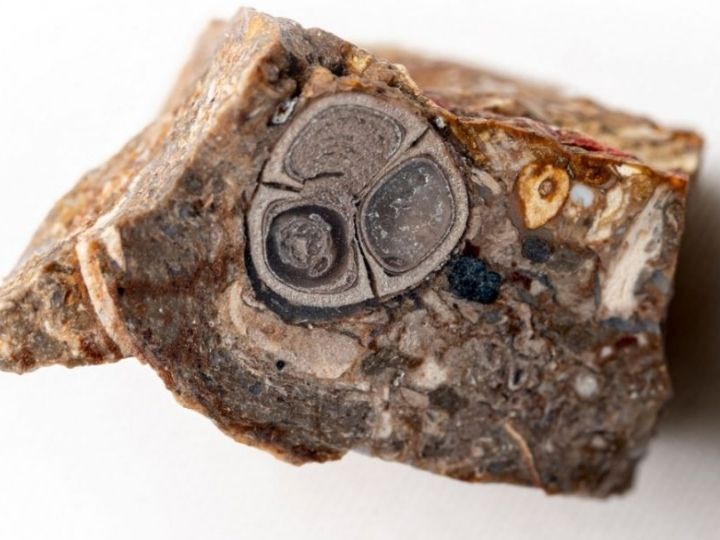Fossils Of Explosive Fruit Sandwiched Between Volcanic Rock Layers Found In India
Scientists from Florida Museum of Natural History recently excavated the fossilised remains of plant material sandwiched between layers of volcanic rock.

New Delhi: India was a rogue subcontinent on a collision course with Asia, just before the Cretaceous Period came to an end. However, before the two landmasses merged, India rafted over a "hot spot" within the Earth's crust. This triggered one of the largest volcanic eruptions in Earth's history, which likely contributed to the extinction of dinosaurs.
Scientists from the Florida Museum of Natural History in the United States recently excavated the fossilised remains of plant material sandwiched between layers of volcanic rock. The findings of the study were recently published in the International Journal of Plant Sciences.
Which Family Do The Fossils Belong To?
In the study, the researchers described a new plant species based on the presence of distinctive fruit capsules that likely exploded to disperse their seeds. According to the study, the fossils may be the oldest fruit discovered to date of the spurge family (Euphorbiaceae). The spurge family is a group of plants with more than 7,000 species, with well-known representatives that include poinsettia, castor oil plant, rubber trees, and crotons.
Where Were The Fossilised Fruits Discovered?
The study said that the fossilised fruits were discovered near the village of Mohgaon Kalan in central India, where the remains of the once-widespread volcanic rock lie just beneath the surface in a complex mosaic.
In a statement issued by the Florida Museum of Natural History, Steven Manchester, senior author of the study, said that one can walk through these hills and find chunks of chert that have just weathered up through the topsoil. He added that some of the best collecting is where farmers have ploughed the fields and moved the chunks to the side.

Manchester said that for a paleobotanist, it is like finding little Christmas presents all along the edge of the fields.
The volcanic eruptions are thought to have lasted for up to one million years, the statement said. The eruptions used to occur in prolonged pulses that blanketed the surrounding landscape in thick lava layers up to one mile deep.
The basalt rocks leftover from the eruptions are known as the Deccan Traps, and cover an area larger than the state of California today.
Volcanic events occurred at the tail end of the Cretaceous.The asteroid impact half a world away may have triggered the most violent of these volcanic events.
Manchester said that the impact in the Yucatan may have caused seismic perturbations that actually disturbed the regime on the other side of the planet, causing lava to erupt.
Limestone, Clays Stacked In A Giant Layer Of Cake
The palaeontologists found the fossilised fruits sandwiched between the basalt. They have found shales, chert, limestone and clays stacked in a giant layer cake of alternating bands, most of which are rich in the fossilised remains of plants and animals, the study said.
According to the study, the fossils provide a glimpse into what seem to have been relatively calm periods of stability between massive lava flows.
The newly described species were likely shrubs or small trees that grew near hot springs by the interaction of groundwater with naturally heated rock beneath the surface, the study said. These areas were similar to present-day environments in Yellowstone National Park in the United States.
India Was Inching Its Way Through The Equator
The study said that at the time of their preservation, India was inching its way through Earth's equatorial zone, creating warm, humid conditions that supported a number of tropical species. These species included bananas, aquatic ferns, mallows, and relatives of modern crepe myrtles.
A common find in the Deccan Traps is petrified wood. Most of these have small diameters. This suggests a lack of large trees whose conspicuous absence has stumped scientists trying to stitch together the ecological history of the region, the study said.
Manchester said that India was positioned at a low altitude, so one could expect to find forest giants. "But that's not what we're seeing," he said.
What Restricted The Growth Of Roots?
Though it is unclear why the trees were unable to obtain greater stature, Manchester suspects that underlying basalt may have restricted the growth of roots, the statement said.
Manchester said that alternatively, the plants may have been part of young forests that grew in volcanically active regions, which would have wiped out the surrounding vegetation before it had a chance to mature.
Manchester said that one is most likely to get fossils preserved when there have been recent eruptions. This is because eruptions create a lot of volcanic ash that can bury and preserve plants.
Peeling Back The Layers Of Mystery Fruit
Dashrath Kapgate, who co-authored the study, found fruits from the new species pristinely preserved in a matrix of chert. The study said that with only the fruits to go on, determining which plants they belonged to required a significant amount of investigative research.
Rachel Reback, lead author of the study, said that it did not really fit well into any known plant group. Reback added that the researchers ended up having to take a large number of CT scans not only of the fossils they had but of the fruit of living species as well so that they could directly compare them.
According to the study, the researchers, by studying similar fruit specimens provided by the Smithsonian Institution, ultimately determined the fossils belonged to the spurge family.
However, one of the fossils was unlike anything the researchers had seen. The scientists determined it represented an entirely new species belonging to the fossil genus Euphorbiaceae, the study said.
The Fruits Were Likely Explosive
The orientation of the fibres inside the fruit indicated that they were likely explosive, the study said. This was a common means of seed dispersal in other euphorbs, including cassava, rubber trees, crown of thorns and castor oil plant.
The fruits in these species begin to dry out once they have ripened. Also, the fruits lose as much as 64 percent of their original weight, which builds up tension in the rigid outer layers, the study said.
Describing the process in rubber trees, Manchester said that once enough water has evaporated, one can hear "this loud pop, and the seeds and pieces of the fruit go flying everywhere".
He said that the researchers think this is the case for these two fossil species as well, because one can see the same anatomy, where the fibres in the inner and outer layers of the fruit wall are oriented in opposing directions. This helps build torque, he said.
India Gave Rise To An Incredible Diversity Found Nowhere Else
The study said that fossils like these offer palaeontologists tantalising clues regarding the origin and movement of species.
A conjoined India and Madagascar began drifting away from the supercontinent Gondwana in the Southern Hemisphere, about 140 million years ago. As the conjoined India and Madagascar started drifting away, they carried with them plants and animals that evolved in isolation throughout the Cretaceous, the study said.
According to the study, India had given rise to an incredible diversity of life found nowhere else, by the time it finally slammed into Eurasia, 10 million years after the extinction of the dinosaurs.
It is likely the first grapes evolved in India, as did the ancestors of whales, the study found.
New groups of insect-eating pitcher plants, flightless birds, lizards, freshwater crabs, scorpions, and mantises all made their way out of India and into new environments in Europe and Asia, as the Himalayas took shape above the sutured landmasses, the study said.
According to the statement, Manchester hopes that these fossils and others like them coming out of the Deccan Traps will help illuminate the distribution of species at a critical time in Earth's history.
According to the statement, Manchester put forward the following question: "What were the environments in India like at a time when it had not yet connected to Eurasia and how do they compare with other regions at that time?"
Manchester said that it is like filling in the pieces of a puzzle.






































